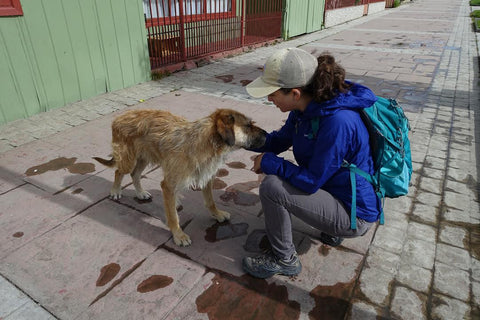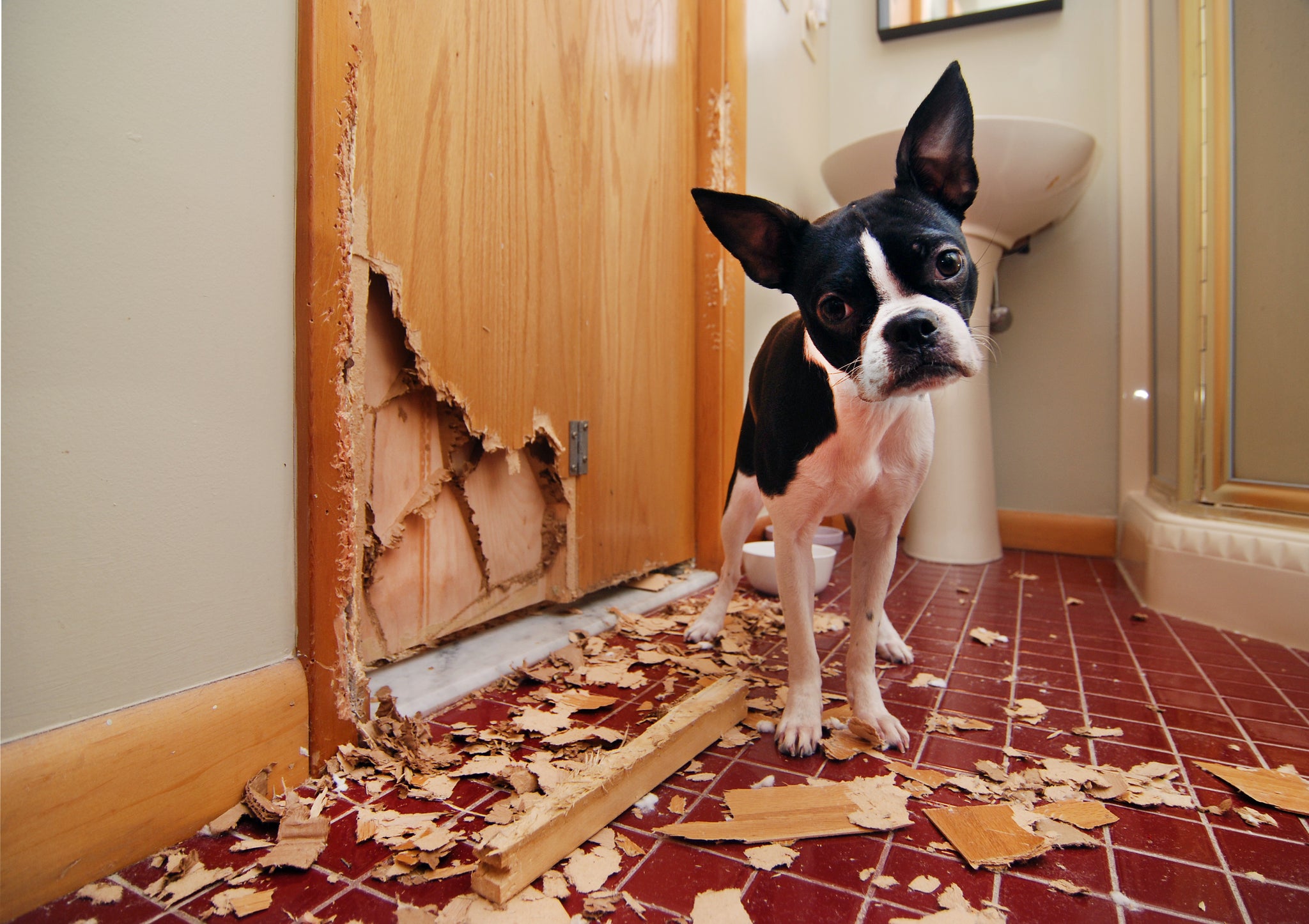Treating Separation Anxiety in Dogs
What is separation anxiety?
Most of us wouldn’t think twice about leaving our dog at home to go pick up take-out or run an errand. But if your dog has separation anxiety, even those 15 minutes can make him so anxious that he injures himself or chews a hole in the wall.
By definition, dogs with separation anxiety are unable to find comfort when separated from family members.
A good friend adopted a dog during veterinary school who developed severe separation anxiety and would chew through crates and walls. Jenna modified her lifestyle and put a lot of effort into helping Millie, but it was worth it to be able to keep the family together. Not all dogs have such severe separation anxiety, but no dog should have to be stressed in the safety of their own home. Your dog should feel good about his or her independent time. It’s always easier to fix while the signs are subtle or infrequent, before separation anxiety becomes a challenge to treat.
What causes separation anxiety?
It is hard to say exactly why dogs develop separation anxiety, but there are many things we can do to prevent it or reduce its severity. It may be based in confinement anxiety, barrier frustration, lack of environmental stimulation, fears of noise or activity outside the house, or sometimes even territorial aggression. A veterinarian or veterinary behaviorist can help distinguish between these. Knowing the cause can help you make a plan specific to your dog. For example, one client of mine had a dog who was only anxious on breezy days when the shadows outside the window moved. But for the most part, the treatment is the same: trying to make your dog feel comfortable being alone.
Not all dogs who show signs commonly associated with separation anxiety are suffering from it. Bored dogs may show very similar signs; the only difference being they are not stressed by your absence. These dogs may settle quietly for the first few moments of your absence and then begin eating the couch only a few hours later. The good news is that the advice below is universally helpful for supporting a happy, healthy dog.

Diagnosing separation anxiety in dogs
The best way to diagnose separation anxiety is by watching a live stream or recording what your dog does when left alone. You can do this with a smartphone and a tablet or computer. For most dogs, the first few minutes are the most difficult. Even the average dog may bark or whimper for a few seconds to a few minutes when you leave, but dogs with separation anxiety display signs of more significant distress.
Watch for barking that won’t stop barking or becomes frenzied, jumping, pacing, or circling. Some dogs mark or eliminate in the house out of stress when left alone. Dog that were happily eating their breakfast may walk away from the bowl and not return to it until their people return. A friend’s dog with severe separation anxiety would start to chew at the floorboard as soon as the garage door closed.
Treatment options for separation anxiety
Modify YOUR behavior
Dogs are very attuned to your emotions – so the calmer you can make your departures and arrivals, the easier they will be for your dog. Delay your excited greeting by putting all your things away and maybe even having a few sips of water before greeting your dog. I always put away my gym bag or my groceries before letting my dog out of his crate.
Ask your dog to perform a cue they know (sit, down, shake) and then start your greeting. Though the difference is subtle, your interaction is a reward for performing that requested behavior rather than just your return home.
Use tools to help calm your dog’s separation anxiety
Be “multi-modal” for the greatest likelihood of success. Every shelter and clinic I’ve worked in keeps the Adaptil pheromone spray in easy reach; it also comes in a collar and a home diffuser. Products containing lavender, chamomile, and other essential oils may also work well for some dogs. (NOTE: never feed your dog pure essential oils or rub them on their fur.) Products containing tryptophan, the amino acid in turkey that makes us tired, have gentle sedative effects on dogs as well. Thundershirts are a great tool for dogs with storm phobias.

Increase physical exercise
Physical exercise is very important to reduce anxiety. Even an extra 10 minutes of engaged play before you leave for work or an evening out can help your dog relax. Engaged play means that you are keeping the dog moving; just letting him or her into the yard is not the same. Longer sessions are better, but they aren’t always feasible on rushed mornings before work or school. Prepare the coffee maker and pack your lunch the night before so you can use those extra few minutes to exercise your dog. In the evening, games of fetch, long walks, dog park visits, or other aerobic activities are also important.
Introduce new training
Train your dog how to relax. Commonly referred to as “mat training,” this teaches your dog that only good things happen when he or she is laying on the designated mat. I recommend searching for videos on YouTube that demonstrate the process. My dog only partially understands the concept and carries his mat to whatever room people are hanging out in and settles there.
Many dog lineages are bred to perform jobs. Don’t let your dog’s job be destroying the house due to separation anxiety. Give your dog a better job through agility training, nose work, herding classes, or other working dog classes even if you’ll never put the training into action. All of this mental exercise will help your dog rest better during the day when you are absent.
Add mental exercise
These types of jobs are great for evenings and weekends but your dog is most anxious on weekdays when you aren’t home. One part of treatment for dogs with mild to moderate separation anxiety is to give them long-lasting rewards for your absence, such as food toys or devices to stay engaged for prolonged periods of time. Make your absence a positive thing for your dog.
For some dogs, a Kong filled with canned food and frozen will be sufficient because it’s only the first few minutes after your departure that are stressful. Other dogs need something longer lasting or that refocuses their attention to something positive throughout the day. This is where the newly-emerging market of pet-focused technology can be especially useful. Devices like the CleverPet [LINK] engage your dog over long periods of time and can give them the mental exercise they need.
CleverPet not only provides distraction from your absence but also engages your dog mentally. This is important because your dog is learning, and being rewarded for, something that he or she chooses to do. This kind of independence can be great for dogs who have only previously only learned how to be anxious when left on their own. One of the unique features of the CleverPet is that it gets harder as your dog learns each game, so it’s an investment that will keep your dog stimulated for a long time. You can even program CleverPet to turn on and off on a schedule.
The hard part about treating separation anxiety
If your dog has moderate to severe separation anxiety, you will need to start a long, slow process to reset the way your dog feels about your absence. This process can be very difficult. If you need help, don’t hesitate to consult your veterinarian or choose a specialist of board-certified veterinary behaviorists. You may need a more detailed plan tailored to your dog’s specific needs and possibly medication.
For dogs with separation anxiety, you can never act too soon.

|
Hanie Elfenbein is an Associate Veterinarian at the Animal Hospital of Towne Lake in Woodstock, Georgia. She earned both her DVM and PhD from the University of California, Davis in Veterinary Medicine and Animal Behavior. Hanie's mission is to provide pet parents with the support they need to have happy, healthy, and fulfilled relationships with their FurKids. On her days off, Hanie works with Jail Dogs, a group that fosters special needs dogs and cats into a local jail so the inmates and the companion animals can rehabilitate each other. When taking a break from it all, she can be found hiking with her American Brown Dog (aka mutt) Loki. |

